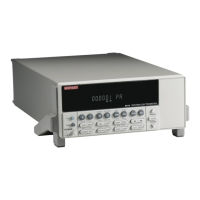12-12 Remote Operation
<NDN> Non-decimal numeric — A non-decimal value that can be used to
program status enable registers. A unique header identifies the format;
#B (binary), #H (hexadecimal) and #Q (octal). See “Programming
Enable Registers” in Section 13 for details.
*SRE #B10001 Set bits B0 and B4 of Service Request
Enable Register
<n> Numeric value — Can consist of an NRf number or one of the following
name parameters: DEFault, MINimum, or MAXimum. When the
DEFault parameter is used, the instrument is programmed to the *RST
default value. When the MINimum parameter is used, the instrument is
programmed to the lowest allowable value. When the MAXimum
parameter is used, the instrument is programmed to the largest allowable
value.
:ARM:TIMer 0.1 Sets timer to 100 msec.
:ARM:TIMer DEFault Sets timer to 0.1 sec.
:ARM:TIMer MINimum Sets timer to 1 msec.
:ARM:TIMer MAXimum Sets timer to 999999.999 sec.
• Angle brackets < > — Used to denote a parameter type. Do not include the brackets in
the program message.
:DISPlay:ENABle <b>
The <b> indicates that a Boolean type parameter is required. Thus, to enable the display,
you must send the command with the ON or 1 parameter as follows.
:DISPlay:ENABle ON or 1
Query commands
The query command requests the presently programmed status. It is identified by the question
mark (?) at the end of the fundamental form of the command. Most commands have a query
form.
:ARM:TIMer? Queries the timer interval
Most commands that require a numeric parameter (<n>) can also use the DEFault,
MINimum, and MAXimum parameters for the query form. These query forms are used to
determine the *RST default value and the upper and lower limits for the fundamental command.
:ARM:TIMer? DEFault Queries the *RST default value
:ARM:TIMer? MINimum Queries the lowest allowable value
:ARM:TIMer? MAXimum Queries the largest allowable value

